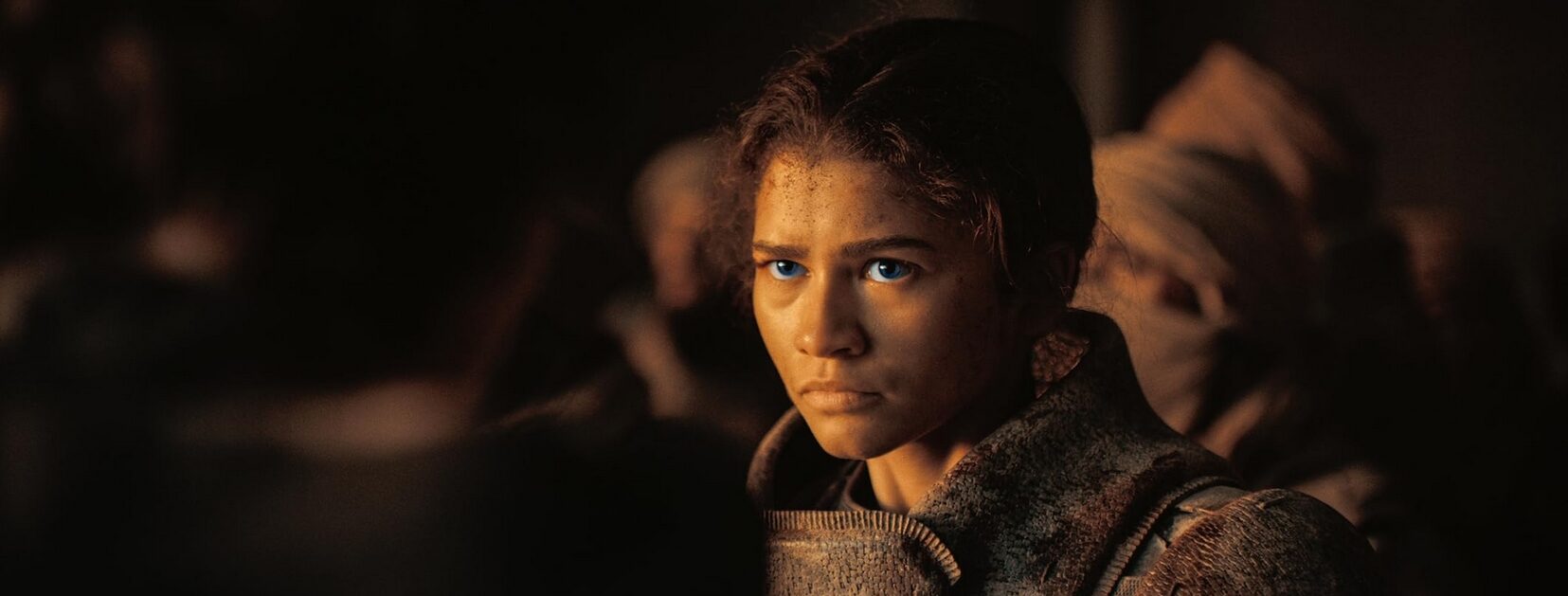Denis Villeneuve’s return to Arrakis promises much, but in some ways, it must. As spectacular as 2021’s DUNE was, it essentially stopped mid-story in the hope of the filmmaker’s paymasters extending the canvas. DUNE: PART TWO improves on its predecessor in some crucial ways, but the reliance on spectacle leaves gaps in the storytelling and a frustratingly ephemeral interest in the most interesting ideas the film brings forward.
The film picks up shortly after the conclusion of the previous instalment, with the family and great house of Paul Atreides (Timothée Chalamet) slaughtered on our last visit to the desert planet Arrakis. He finds himself ascending to messianic status amongst the native Fremen people (a seed planted by his mother’s religious cult, the Bene Gesserit) and seeking revenge for his family’s massacre at the behest of Baron Harkonnen (Stellan Skarsgård), backed by the Emperor (Christopher Walken). Paul’s developing relationship with Chani (Zendaya) – sceptical of the prophecy of a saviour, Lisan Al-Gaib, which Paul seemingly embodies – provides a counterweight to the meddling of his mother, Lady Jessica (Rebecca Ferguson). As Paul battles with whether to seize the power he could as a religious figurehead, a new foe comes to the fore in Feyd-Rautha Harkonnen (Austin Butler), a ruthless and psychotic replacement as the coordinator of the Harkonnen campaign on Arrakis.
The scope of DUNE: PART TWO is sweeping in both visual and thematic terms, and if the above summary seems abrupt to those familiar with Frank Herbert’s books, it is because it would be easy to get lost in the mythology of even this condensed version of his work. On the visual front, whatever viewers and critics wrote about the spectacle of DUNE applies to its sequel: Villeneuve’s vision remains writ large. It’s possible to argue Greig Fraser’s cinematography here is less impactful and blander than DUNE or THE BATMAN. Still, imaginative visuals such as the otherworldly desaturation of the Harkonnen home world or the use of blue to penetrate past the browns and tans of Arrakis show the film still has a few tricks up its sleeve.

“Zendaya’s performance, balancing vulnerability as Paul’s romantic partner, fearlessness as a fighter, and scepticism as a Lisan Al-Gaib doubter, give the film an emotional core that was achingly absent before.”
Additionally, Chalamet gives one of his more impressive performances to date. As Paul slowly starts to give in to the leadership expectations and hopes of others, there is a wide-eyedness to his performance that Chalamet’s harsher critics (with this critic guilty as charged) likely did not expect. Ferguson is engaging as Lady Jessica, but the abundant screen time for those with truncated roles in DUNE represents the film’s most significant improvement from part one. Zendaya’s Chani is given time to be sketched out in a way not many other characters are – including protagonist Paul. Zendaya’s performance, balancing vulnerability as Paul’s romantic partner, fearlessness as a fighter, and scepticism as a Lisan Al-Gaib doubter, give the film an emotional core that was achingly absent before. Javier Bardem’s Stilgar also puts forward an earnestness with his religious fervour and hope for a saviour, which puts a bitter sting in the darker aspects of Paul’s role as messiah.
With all this said, despite some visual cues and explicit script signalling points that signal the more dystopian aspects of Paul’s rise to power, it’s hard to escape the feeling that reading this in DUNE: PART TWO as a film is extratextual, and instead based on the direction of the Dune novels which followed the ones adapted here. There are a lot of ideas introduced and skirted over – as in part one – around colonial exploitation, white saviour tropes, demagoguery, religion’s role in authoritarian systems, and more. However, few are given time to develop. Within the confines of a sub-three-hour film and sub-six-hour pair, perhaps this isn’t surprising but probably illustrates the core problem with both instalments and DUNE: PART TWO in particular: the sheer scope defies conceptual neatness.

“…it’s remarkable a blockbuster film can even seek to introduce some of the themes it does, but that ambition makes it more frustrating that it paints a broad and spectacular canvas with no interest in going deeper (or perhaps no ability to).”
In contrast, Denis Villeneuve’s previous sci-fi forays did possess the conceptual neatness required to communicate underlying ideas effectively. ARRIVAL’s wedding of unique alien language and imagery to reimagine the human understanding of our lives is a simple emotional hook on an engaging set of mechanics. BLADE RUNNER 2049 provides a visually stunning and emotionally resonant extension of a simple human aspect of the 1982 original. The direct inspirations for DUNE (or things inspired by the novel, depending on your viewpoint) and things almost explicitly evoked, such as STAR WARS and GLADIATOR, have greater fleetness of foot and simplicity of plot. DUNE: PART TWO obviously aims for a different tone than those, and it’s remarkable a blockbuster film can even seek to introduce some of the themes it does, but that ambition makes it more frustrating that it paints a broad and spectacular canvas with no interest in going deeper (or perhaps no ability to). This entry leans more heavily on the religious and autocratic readings of Paul’s rise amongst the Fremen. However, without much weight behind it, said leaning doesn’t leave a deep impression.
It’s heartening that a film of this scope – in all senses – can exist in the modern cinematic canon. However, as engaging and awe-inducing as it can be, the rush of sensory input distracts from the fact it has only a passing interest in engaging the audience’s critical faculties with its characters. DUNE: PART TWO resolves one of the major flaws with DUNE – its emotional dryness – but neglects to use that renewed zeal to meaningfully deepen any of the main ideas introduced across either part.
One thing the two modern DUNE films show, if sparingly, is that one person’s Lisan al-Gaib is another’s oppressor in waiting. The film itself can also have dual identities, and how you resolve the balance between breathtaking extravaganza and frustratingly limited melange marks out whether you end up a true believer or a cinematic agnostic.

